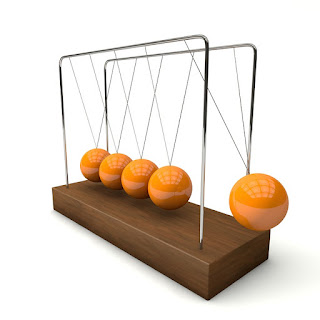First sight the eight physical systems :
- a simple pendulum, a mass $m$ swinging at the end of a light rigid rod of length $l$
- a flat disc supported by a rigid wire through its centre and oscillating through small angles in the plane of its circumference
- a mass fixed to a wall via a spring of stiffness $s$ sliding to and fro in the $x$ direction on a frictionless plane
- a mass $m$ at the centre of a light string of length $2l$ fixed at both ends under a constant tension $T$. The mass vibrates in the plane of the paper
- a frictionless U-tube of constant cross-sectional area containing a length $l$ of liquid, density $\rho$, oscillating about its equilibrium position of equal levels in each limb
- an open flask of volume $V$ and a neck of length $l$ and constant cross-sectional area $A$ in which the air of density $\rho$ vibrates as sound passes across the neck
- a hydrometer, a body of mass $m$ floating in a liquid of density $\rho$ with a neck of constant cross-sectional area cutting the liquid surface. When depressed slightly from its equilibrium position it performs small vertical oscillations
- an electrical circuit, an inductance $L$ connected across a capacitance $C$ carrying a charge $q$
Thus, this restoring force $F$ may be written
\[F=-sx\]
where $s$, the constant of proportionality, is called the stiffness and the negative sign shows that the force is acting against the direction of increasing displacement and back towards the equilibrium position. A constant value of the stiffness restricts the displacement $x$ to small values (this is Hooke’s Law of Elasticity). The stiffness s is obviously the restoring force per unit distance (or displacement) and has the dimensions \[\frac{force}{distance}=\frac{MLT^{-2}}{L}\]
The equation of motion of such a disturbed system is given by the dynamic balance between the forces acting on the system, which by Newton’s Law is \[mass\,times\,acceleration=restoring\,force\]
or \[m\ddot{x}=-sx\]
where the acceleration \[\ddot{x}=\frac{d^{2}x}{dt^{2}}\]
This gives \[m\ddot{x}+sx=0\]
Or \[\ddot{x}+\frac{s}{m}x=0\]
where the dimensions of \[\frac{s}{m}\,\,are\,\,\frac{MLT^{-2}}{ML}=T^{-2}=\nu^{2}\]
Here $T$ is a time, or period of oscillation, the reciprocal of $v$ which is the frequency with which the system oscillates.
However, when we solve the equation of motion we shall find that the behaviour of $x$ with time has a sinusoidal or cosinusoidal dependence, and it will prove more appropriate to consider, not $\nu$, but the angular frequency $\omega$ = $2\pi\nu$ so that the period \[T=\frac{1}{\nu}=2\pi \sqrt{\frac{m}{s}}\]
becomes \[\ddot{x}+\omega ^{2}x=0\]


